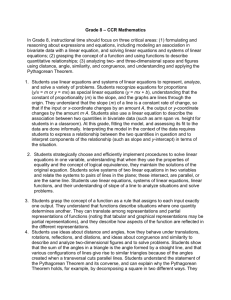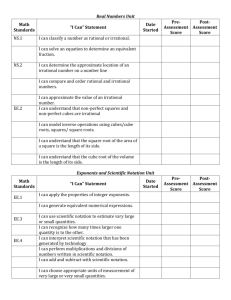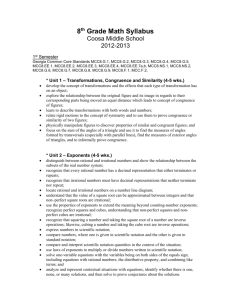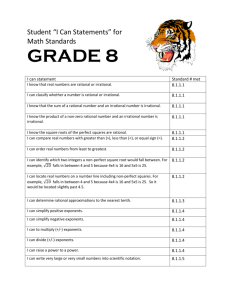Syllabus
advertisement
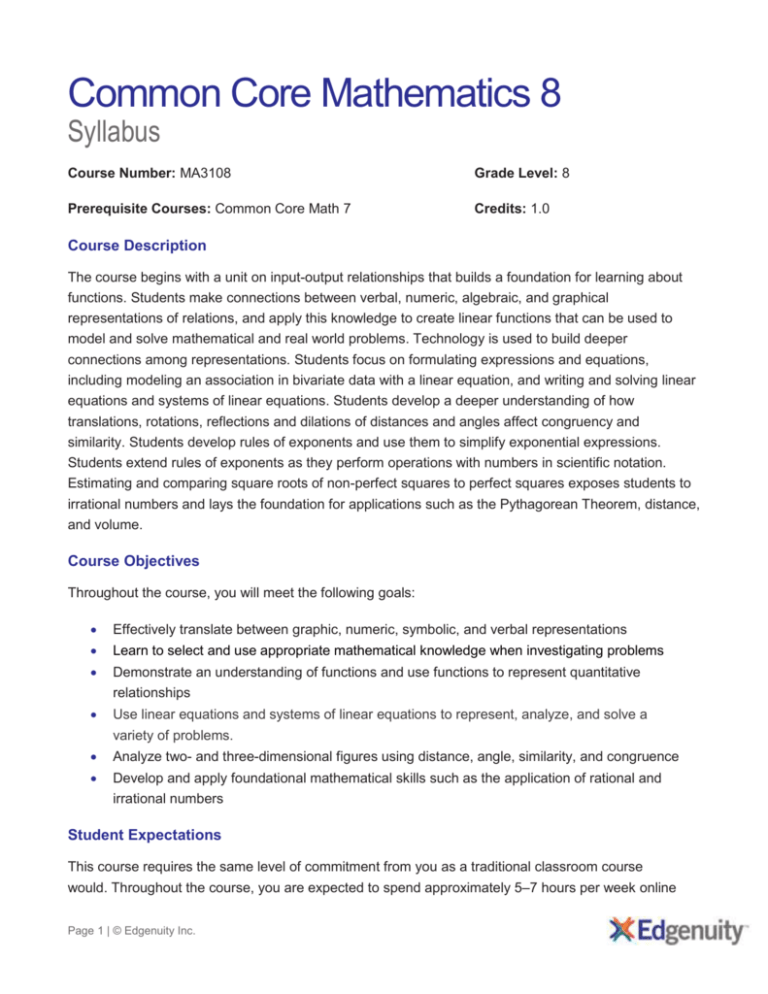
Common Core Mathematics 8 Syllabus Course Number: MA3108 Grade Level: 8 Prerequisite Courses: Common Core Math 7 Credits: 1.0 Course Description The course begins with a unit on input-output relationships that builds a foundation for learning about functions. Students make connections between verbal, numeric, algebraic, and graphical representations of relations, and apply this knowledge to create linear functions that can be used to model and solve mathematical and real world problems. Technology is used to build deeper connections among representations. Students focus on formulating expressions and equations, including modeling an association in bivariate data with a linear equation, and writing and solving linear equations and systems of linear equations. Students develop a deeper understanding of how translations, rotations, reflections and dilations of distances and angles affect congruency and similarity. Students develop rules of exponents and use them to simplify exponential expressions. Students extend rules of exponents as they perform operations with numbers in scientific notation. Estimating and comparing square roots of non-perfect squares to perfect squares exposes students to irrational numbers and lays the foundation for applications such as the Pythagorean Theorem, distance, and volume. Course Objectives Throughout the course, you will meet the following goals: Effectively translate between graphic, numeric, symbolic, and verbal representations Learn to select and use appropriate mathematical knowledge when investigating problems Demonstrate an understanding of functions and use functions to represent quantitative relationships Use linear equations and systems of linear equations to represent, analyze, and solve a variety of problems. Analyze two- and three-dimensional figures using distance, angle, similarity, and congruence Develop and apply foundational mathematical skills such as the application of rational and irrational numbers Student Expectations This course requires the same level of commitment from you as a traditional classroom course would. Throughout the course, you are expected to spend approximately 5–7 hours per week online Page 1 | © Edgenuity Inc. on the following activities: Interactive lessons that include a mixture of instructional videos and tasks Assignments in which you apply and extend learning in each lesson Assessments, including quizzes, tests, and cumulative exams Communication Your teacher will communicate with you regularly through discussions, email, chat, and system announcements. You will also communicate with classmates, either via online tools or face to face, as you collaborate on projects, ask and answer questions in your peer group, and develop your speaking and listening skills. Grading Policy You will be graded on the work you do online and the work you submit electronically to your teacher. The weighting for each category of graded activity is listed below. Grading Category Weight Lesson Quizzes 20% Unit Tests 30% Cumulative Exams 20% Assignments 20% Projects 10% Additional 0% Scope and Sequence When you log into Edgenuity, you can view the entire course map—an interactive scope and sequence of all topics you will study. The units of study are summarized below: Unit 1: Input-Output Relationships Unit 7: Algebraic Approaches to Linear Systems Unit 2: Linear Functions Unit 3: Writing Equations for Linear Relationships Unit 8: Transformations Unit 9: Congruence and Similarity Unit 4: Patterns in Bivariate Data Unit 10: Working with Exponents Unit 5: Linear Equations Unit 6: Representing Linear Systems Graphically Unit 11: Pythagorean Theorem and Irrational Numbers Page 2 | © Edgenuity Inc. Unit 12: Volume








